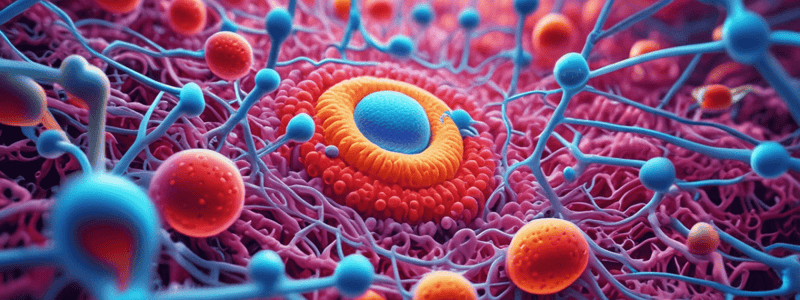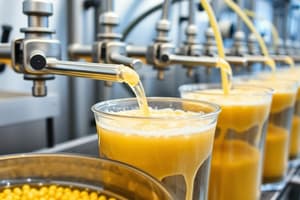Podcast
Questions and Answers
Which type of microorganism is primarily responsible for the pickling of vegetables?
Which type of microorganism is primarily responsible for the pickling of vegetables?
- Leuconostoc species (correct)
- Lactobacillus species
- Aspergillus species
- Escherichia coli
Which characteristic of Actinomycetes is not mentioned in the text?
Which characteristic of Actinomycetes is not mentioned in the text?
- They have branching filamentous hyphae.
- They have peptidoglycan in their cell walls.
- They can produce secondary metabolites like antibiotics.
- They are about 1.0-1.5 μm in diameter. (correct)
What is the primary industrial use of Rhizopus and Mucor, which are classified as Phycomycetes?
What is the primary industrial use of Rhizopus and Mucor, which are classified as Phycomycetes?
- Production of antibiotics
- Production of ethanol
- Production of enzymes (correct)
- Production of aflatoxin
Which characteristic of industrial microbes is NOT mentioned in the text?
Which characteristic of industrial microbes is NOT mentioned in the text?
Which fungal group is known for producing the antibiotic penicillin?
Which fungal group is known for producing the antibiotic penicillin?
What is the primary advantage of microorganisms over plants and animals for industrial applications?
What is the primary advantage of microorganisms over plants and animals for industrial applications?
Which type of bacteria is responsible for the incomplete oxidation of alcohol to acetic acid?
Which type of bacteria is responsible for the incomplete oxidation of alcohol to acetic acid?
Which property of the Acetic Acid Bacteria allows them to thrive in acidic conditions?
Which property of the Acetic Acid Bacteria allows them to thrive in acidic conditions?
What is the difference in cell structure between Acetobacter and Gluconobacter, two Acetic Acid Bacteria?
What is the difference in cell structure between Acetobacter and Gluconobacter, two Acetic Acid Bacteria?
Which of the following is NOT a key advantage of using microorganisms for industrial applications compared to plants and animals?
Which of the following is NOT a key advantage of using microorganisms for industrial applications compared to plants and animals?
What is the main function of ribosomes in cells?
What is the main function of ribosomes in cells?
Which statement is true about the cell walls of prokaryotic cells?
Which statement is true about the cell walls of prokaryotic cells?
In which type of cells does the mitochondria play a role in respiration and energy release?
In which type of cells does the mitochondria play a role in respiration and energy release?
What distinguishes the DNA organization between prokaryotic and eukaryotic cells?
What distinguishes the DNA organization between prokaryotic and eukaryotic cells?
Which domain is not classified under the three domains of living organisms mentioned in the text?
Which domain is not classified under the three domains of living organisms mentioned in the text?
Which of the following statements about lactic acid bacteria is correct?
Which of the following statements about lactic acid bacteria is correct?
Which of the following processes is NOT mentioned in the given text?
Which of the following processes is NOT mentioned in the given text?
Which of the following statements about the Firmicutes phylum is correct?
Which of the following statements about the Firmicutes phylum is correct?
Which of the following genera is NOT mentioned as belonging to the lactic acid bacteria group?
Which of the following genera is NOT mentioned as belonging to the lactic acid bacteria group?
Which of the following statements about the Bacillus genus is correct?
Which of the following statements about the Bacillus genus is correct?
What is the primary characteristic that distinguishes industrial microbiology from other fields of microbiology?
What is the primary characteristic that distinguishes industrial microbiology from other fields of microbiology?
Which of the following best describes the meaning of 'fermentation' in industrial microbiology?
Which of the following best describes the meaning of 'fermentation' in industrial microbiology?
What is the typical scale of microorganism cultivation in industrial microbiology processes?
What is the typical scale of microorganism cultivation in industrial microbiology processes?
Which of the following is NOT a characteristic of industrial microbiology?
Which of the following is NOT a characteristic of industrial microbiology?
Which of the following processes is NOT considered a type of fermentation in industrial microbiology?
Which of the following processes is NOT considered a type of fermentation in industrial microbiology?
Which characteristic is most important for an industrial microorganism to maximize profits?
Which characteristic is most important for an industrial microorganism to maximize profits?
Which factor should be considered when choosing between two microorganisms for product recovery?
Which factor should be considered when choosing between two microorganisms for product recovery?
What advantage does a thermophilic microorganism have in an industrial fermentation process?
What advantage does a thermophilic microorganism have in an industrial fermentation process?
Which statement best describes the importance of cell structure in industrial fermentations?
Which statement best describes the importance of cell structure in industrial fermentations?
Which characteristic is most important when choosing a microorganism for the production of fermented foods?
Which characteristic is most important when choosing a microorganism for the production of fermented foods?
Which characteristic of lactic acid bacteria is NOT mentioned in the text as desirable for industrial purposes?
Which characteristic of lactic acid bacteria is NOT mentioned in the text as desirable for industrial purposes?
What is a key advantage of lactic acid bacteria in industrial applications according to the text?
What is a key advantage of lactic acid bacteria in industrial applications according to the text?
What distinguishes Actinobacteria from other Firmicutes according to the text?
What distinguishes Actinobacteria from other Firmicutes according to the text?
Which characteristic is crucial for the industrial importance of Pediococcus among the Actinobacteria mentioned in the text?
Which characteristic is crucial for the industrial importance of Pediococcus among the Actinobacteria mentioned in the text?
What sets Lactococcus apart as an industrially important member among the Actinobacteria discussed in the text?
What sets Lactococcus apart as an industrially important member among the Actinobacteria discussed in the text?
How do lactic acid bacteria differ from Actinobacteria in terms of byproducts production as mentioned in the text?
How do lactic acid bacteria differ from Actinobacteria in terms of byproducts production as mentioned in the text?
Why are Actinobacteria considered Firmicutes with G+C content of 50% or higher according to the text?
Why are Actinobacteria considered Firmicutes with G+C content of 50% or higher according to the text?
What makes Streptococcus stand out among the Actinobacteria noted in the text?
What makes Streptococcus stand out among the Actinobacteria noted in the text?
Which condition is crucial for the growth of Actinobacteria as mentioned in the text?
Which condition is crucial for the growth of Actinobacteria as mentioned in the text?
Flashcards are hidden until you start studying
Study Notes
Microorganisms in Food Preservation and Fermentation
- Pickling of Vegetables: Lactic acid bacteria are primarily responsible for pickling.
- Acetic Acid Bacteria: Incomplete oxidation of alcohol to acetic acid is caused by Acetobacter type bacteria.
- Thermophilic Advantage: Thermophilic microorganisms thrive at higher temperatures, providing efficiency in fermentation processes.
Industrial Microbiology
- Rhizopus and Mucor: These Phycomycetes are primarily used in the production of enzymes and fermented foods.
- Industrial Microbes: The ability to replicate rapidly is a shared characteristic; however, not all characteristics are mentioned.
- Fermentation Meaning: Fermentation refers to the anaerobic conversion of sugars to acids, gases, or alcohol by microorganisms.
Bacterial Characteristics and Functions
- Acetic Acid Bacteria's Acid Tolerance: Acetic Acid Bacteria possess a high resilience to acidic environments, allowing growth in vinegar.
- Cell Structure Differences: Acetobacter has a different cell wall composition compared to Gluconobacter, influencing their metabolic functions.
Prokaryotes vs. Eukaryotes
- Prokaryotic Cell Walls: Prokaryotic cells generally have a peptidoglycan-based cell wall.
- Mitochondria Function: Only eukaryotic cells utilize mitochondria for respiration and energy release.
- DNA Organization: Prokaryotic DNA is circular and not enclosed within a nucleus, contrasting with the linear, nucleus-bound DNA in eukaryotes.
Prokaryotic Domains
- Undisclosed Domain: A domain not mentioned among the three classifications is Archaea.
Lactic Acid Bacteria Insights
- Lactic Acid Characteristics: Desirable traits include being non-pathogenic and producing lactic acid without gas buildup.
- Firmicutes Correct Statement: Not all bacteria classified under Firmicutes are lactic acid bacteria.
- Bacillus Genus: Known for producing spores that confer resilience and durability.
Industrial Applications of Microorganisms
- Industrial Microbiology Definition: Focuses on microbial processes and products for commercial use, distinguishing it from other microbiology branches.
- Cultivation Scale: Microorganism cultivation in industrial settings typically occurs on a large scale for mass production.
- Key Characteristics: High yield and cost-effectiveness are critical for industrial microorganisms.
Choosing Microorganisms in Industry
- Product Recovery Factors: Consideration should focus on the microorganism's yield, productivity, and byproduct formation.
- Fermented Food Production: Selection criteria emphasize flavor production and safety.
Lactic Acid Bacteria Variability
- Byproduct Differences: Lactic acid bacteria primarily produce lactic acid, while Actinobacteria may produce other metabolites.
- Actinobacteria in Firmicutes: Classified based on G+C content, which is 50% or higher.
Notable Actinobacteria Features
- Pediococcus Importance: A critical feature for Pediococcus in industry is its ability to produce lactic acid in varied conditions.
- Lactococcus Distinction: High efficiency in converting carbohydrates to lactic acid sets Lactococcus apart.
- Streptococcus Characteristics: Known for its carbohydrate fermentation capabilities.
Growth Conditions for Actinobacteria
- Growth Condition: A specific nutrient profile is fundamental for the growth of Actinobacteria in industrial settings.
Studying That Suits You
Use AI to generate personalized quizzes and flashcards to suit your learning preferences.




